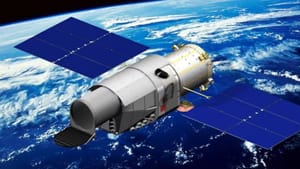
Dec 18, 2023
Lunar Crater Radio Telescope: The Future of Ground Based Radio Astronomy?
Radio Astronomy has helped humanity better understand the cosmos for nearly 100 years. But radio astronomy from the ground, here on Earth, is proving to be far more tricky as the years go by. As satellite numbers in LEO grow, more and more man made radio waves are interfering with Earth based radio astronomy. This, is obviously bad, as deep space radio waves are harder to find and observe due to their very faint nature. The Earths ionosphere also impedes these faint radio signals, by reflecting them.
To solve this issue, we cannot simply stop using satellites, that would never happen (or make sense). We also cannot remove the Earths ionosphere…so, what can be done to combat something like this?
Far Side of The Moon: Radio Silent Haven
Luckily, our closest celestial neighbor may be the key solution to such a problem. As our moon is tidally locked to us, the far or ”dark” side of the moon, is always facing away from us. This crucially means, the far side of the moon is facing away from nearly all of our manmade radio signals. The Moon also lacks an atmosphere, meaning the faintest of signals aren’t reflected by an ionosphere.

Thats where the Lunar Crater Radio Telescope (LCRT) comes in. LCRT is a NASA/JPL proposed telescope, that, is built WITHIN a lunar crater. The 1km wide telescope would be the largest of its kind. And while it sounds crazy, it is well within the realm of possibility, especially as more and more SHLV’s come online.
How LCRT Would Be Built
Building large structures on the moons has one major benefit, low gravity. An object on the Moon only experiences about 1/6th of the gravity that same object would experience on Earth. This means that things on the Moon weigh less. A 100kg object on Earth would only weigh about 16kgs on the Moon. Because of this lower gravity environment, large structures need far less support than what Earths gravity would require.
The issue with construction on the Moon however, is both the cost of getting resources to the designated destination and the physical construction. This begs the question, how would the LCRT be constructed?

Seen above is a proposed concept of how the Lunar Crater Radio Telescope would be built. The DuAxel anchors and Telescope would be attached at arrival, but would separate as they near the crater. The telescope would then land as close to the center of the crater as possible, while the DuAxels would land on the outskirts of the crater.
The Telescope lander then unfolds and deploys its guide wires. While this is occurring, the DuAxel anchors descend links to meet up and attach to the guide wires. Once the Axels link up with the guide wire, they would hoist the receiver before they lift the wire mesh telescope.
What LCRT Would Study and What it Might Find
So, what will LCRT study? As mentioned earlier in this article LCRT would be in a unique position to study the cosmic dark ages. This is the period after the big bang where stars and galaxies were starting to form, but a "fog" of hydrogen trapped/reflected any light from these early formative years of our universe.

LCRT would study the faint radio signals emitted from the abundant amount of Hydrogen at the time of the dark ages. Helping astronomers better understand the forming of the early Universe. While it isn’t certain, LCRT could shine insight into the formation of the Universe’s earliest stars and it may even help uncover mysteries surrounding dark matter and energy.
LuSEE-Night: LCRT's Little Sister
Before NASA invests billions into the development, manufacturing and assembly of the Lunar Crater Radio Telescope, they want to do a small scale demonstration on the Lunar surface. That is where the "Lunar Surface Electromagnetics Experiment" - Night (LuSEE-Night) comes in. LuSEE is a NASA and Department of Energy (DOE) led technology demo that will lay the foundation for LCRT.

LuSEE is planned to land on the lunar surface by 2026 and it is planned to have a mission life span of around 18 months. Even though LuSEE is a technology demonstration for a potential LCRT, it still will bring in immense science, as it too will study the “Cosmic Dark Ages” in both higher quality and in ways never done before. Because of LuSEEs position on the Moon, information and data collected will need to be beamed into an orbital relay satellite, that will send said data back to Earth.
An important function of the LuSEE telescope is to ensure that a sensitive instrument can survive the harsh conditions of the lunar surface. If LuSEE is successful and the information collected is promising, development into LCRT will likely continue further.
LCRT and its Obstacles
LCRT has a wide variety of obstacles, from design challenges, to on-sight assembly, cost, communication, the local environment, a growing human presence on the Moon and actually getting to the Moon.
These challenges, while not avoidable, aren‘t unsolvable. A relay could be built around the Moon, helping keep the “dark” side of our natural satellite, a little less so. Super Heavy Lift Launch Vehicles, like Starship, New Glenn, Terran R and SLS are all capable options to deliver the LCRT to the Lunar surface.

As human presence grows on the Moon, the “pristine” qualities that started the idea of a LCRT, such as very low interference by man made radio waves, will start to disappear. This will make some rethink the importance of the telescope, calling into question its longevity and if its worth the cost.
And while, yes, the telescope may not have the most quiet observing environment in 25 years time, the information gained in that time would be worth every penny and more.



